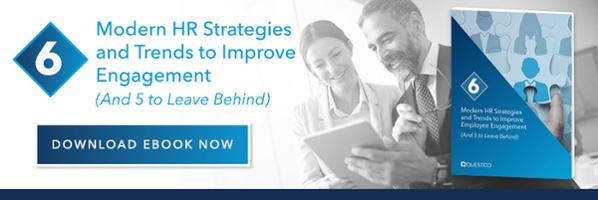Topic Business Performance
The Importance of Employee Assistance Plans
.jpeg)
February 8, 2021 | By Laura Platero
.jpeg)
In the workplace, promoting and supporting employees’ mental health is not just something that can positively impact the business; it is necessary to achieve an efficient and productive workforce.
An effective Employee Assistance Plan (EAP) will support employees’ physical health and emotional well-being by acknowledging and addressing the issues impacting the health of employees and workplace productivity. Employee Assistance Plans are growing in popularity because they are designed to boost employees’ performance by helping resolve personal issues.
What is an EAP?
An Employee Assistance Plan is a work-based program that provides employees and their families with resources that can help them overcome some of life's biggest challenges related to work, family, financial matters, legal matters, and more.
An EAP is more than a plan that offers services to help employees deal with personal problems. An EAP can reduce health care costs, absenteeism, and disability claims, while increasing employee morale and productivity. An EAP is a plan that impacts not only the employees but also the employers responsible for developing and implementing the plan.
Types of EAPs
Employee Assistance Plans provide an array of services and resources. EAPs will come in a variety of shapes and sizes, and the cost of EAPs will vary. The factors that will determine the types and cost of an Employee Assistance Plan will include the number of employees, the industry, workplace policies, and regulatory requirements.
Three common types of EAPs that companies provide are:
- Individual services
- Managerial/Supervisory Services
- Organizational services
Individual Services
Individual services are delivered to individual employees and their covered family members. Individual services are the most common services provided by EAPs. Services provided for individuals include the following:
- Assessment
- Referrals
- Follow-ups
- Treatment planning
- Collaboration with others
Individual services include performing clinical care assessments, providing short-term counseling, and recommending self-help educational resources. The most common types of individualized services that an EAP can provide are assessments, referrals, and counseling.
Managerial/Supervisory Services
While individual services are the most common services provided by EAPs, EAP services are also available to managers and supervisors. Some services provided to managers and supervisors include offering guidance about supporting employees, supporting work accommodations efforts, training/education, and other coaching and management services.
Services provided for managers and supervisors include the following:
- Assistance in referring employees to the EAP
- Performance management guidance and consultation services related to the performances and conduct of employees
- Training and education for managers and supervisors
- Instruction and teaching on how to support employees with personal problems that could be impacting their well-being
Organizational Services
EAP services are not only provided at the management and supervisor levels, but they are also provided at the organizational level. EAPs provide services at this level, including response services for crisis and traumatic events, leading support groups, and supporting organizational changes.
Services provided for organizations include the following:
- Crisis management
- Employee orientation
- Educational programs and services
- Traumatic incident services
Why Are Some Employees Hesitant About EAPs?
Unfortunately, despite their popularity in some workplaces, EAPs are not utilized throughout every workplace. One of the reasons many employees are hesitant to use an EAP is because they are not familiar with an EAP. Those who are not familiar with EAPs are less likely to use the services. Some employees believe that the services provided by EAPs are only available for people who have mental health concerns.
Lack of program education, misinformation, and a fear of being stigmatized or perceived badly by their boss are only a few reasons why many employees believe EAP services are not meant for them. It is important to increase awareness of EAPs and encourage everyone to be informed about EAPs and their services.
Why is an EAP Important?
There is an array of factors that can support or damage an employee's ability to work at their potential or exceed their potential. Personal or professional problems, depression, abuse, and financial problems are only some factors. Today, more workplaces are beginning to understand the role these issues can have on individuals and the entire workplace.
Benefits of an EAP
When the struggles and challenges of life outpace one's ability to cope, productivity and performance can be negatively impacted. When the proper support is available, employees will manage stress and find solutions to their problems. How can you effectively combat absenteeism in the workplace? How can you increase production in the workplace?
These are both questions that an effective Employee Assistance Plan can answer. The positive influence of using an EAP include the following:
- Reduction in absenteeism
- Increase in productivity
- Positive work environment
- Increase in retention
- Decrease in labor disputes
Ensuring that everyone remains motivated and inspired every day will play a major role in engagement and performance. Employees who are satisfied and engaged with their daily work responsibilities will generally remain with the company longer. Access to an EAP can keep employees engaged and empower them to lead lives that are healthy and fulfilling.
Considering an EAP
If you partner with a Professional Employer Organization, your employees will have access to a wealth of benefits, including an EAP. A PEO has the ability to administer EAPs in a manner that will generate a positive ROI. For every $1 that a workplace spends on mental health initiatives, the return on investment will be greater than $2. Offering an EAP to employees will underline a company's commitment to everyone’s health and success inside and outside the company.
.jpg)
Laura Platero
Laura serves as the Director of Product Strategy. She is an expert in large scale benefits account management, project management, product development, sales, customer service, and benefits consulting.




